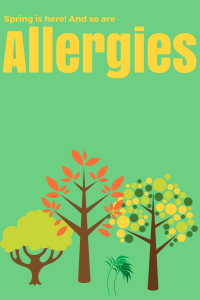 Spring is here, which means that it’s time for favorite outdoor activities in South Louisiana: picnics, barbecues, crawfish boils, and fishing. Unfortunately, the pleasant weather brings an unwanted side effect for some people – spring allergies. According to a recent study by the Asthma and Allergy Foundation of America, Baton Rouge ranks at #3 with a higher than average pollen score. Because Louisiana has relatively mild winters and high humidity, many allergy suffering residents experience symptoms year-round. Between potent indoor allergens and high dust mite counts, we are left with mold spore counts that are high year-round. Then, you have winter and spring allergies.
Spring is here, which means that it’s time for favorite outdoor activities in South Louisiana: picnics, barbecues, crawfish boils, and fishing. Unfortunately, the pleasant weather brings an unwanted side effect for some people – spring allergies. According to a recent study by the Asthma and Allergy Foundation of America, Baton Rouge ranks at #3 with a higher than average pollen score. Because Louisiana has relatively mild winters and high humidity, many allergy suffering residents experience symptoms year-round. Between potent indoor allergens and high dust mite counts, we are left with mold spore counts that are high year-round. Then, you have winter and spring allergies.
If you’re one of the millions of allergy sufferers in the U.S. picnics and fishing might not have you jumping for joy.
Spring allergies are made worse by pollen
Because there can be millions of pollen particles in the air, finding allergy relief can seem nearly impossible for some. But by knowing what triggers your allergy symptoms and how to avoid these allergens, you can be on your way to a sneeze-free season. Although living in south Louisiana makes avoiding your spring allergy triggers seem impossible. Spring means everything is in full fruition, and allergy and asthma sufferers have even more to battle.
Currently, Louisiana is entering tree pollen season. While some of the allergy triggers, such as elm and cedar, are already out, the biggest culprit, oak, is about to flourish. In late March and April, pecan tree pollen will express even more yellow powder into the air. But the misery is just beginning for the highly allergic. April signals the beginning of grass pollen season, which lasts through early fall.
A big help can come from keeping up with the days pollen count. This can be found online and on the weather channel. Based on what you read or hear, try to avoid exposure at high pollen count times, mainly from dawn until mid-morning. Water lawns and flower beds in the early evening and play sports in the evenings and afternoons. Avoid parks, forests and outdoors areas as much as possible until afternoon. And remember that pets and people bring pollen inside, so taking a few extra minutes to clean off shoes, clothing and paws will really help.
Fighting off spring allergies
You can start by remembering the three A’s: allergy avoidance, allergy medications, and allergy shots.
A new set of guidelines from the American Academy of Otolaryngology offers the latest advice for diagnosing and treating hay fever. It’s a newly developed immunotherapy treatment that only involves a few drops of liquid in the mouth once a day. The group also recommends patients use a newer generation of antihistamines that are known to be less sedating. Steroids can also help serious allergy sufferers. Additionally, acupuncture is recommended when a patient wants a more natural way to ease their symptoms.
If your allergies are exacerbated frequently, keep a log to identify specific triggers. Note the time of day they occur, weather conditions and where you are when they flare up. Del Junco suggests recording answers to questions such as:
- When symptoms occur, how long do they last?
- Do your symptoms happen when you’re outdoors or indoors, like when you clean your house?
- Do they get worse when you’re around pets?
- What makes your symptoms better?
- What types of treatments have you tried?
- Around cigarettes?
If you feel like you are doing your best to control your spring allergies and they’re still interfering with your life, it may be time to see a doctor. If spring allergy symptoms are not fixed with over-the-counter medications and environmental control measures like keeping your windows shut or removing pollens from you hair, skin and clothes, then it is time to seek medical attention from a Coastal Urgent Care Doctor.
